The Balance Sheet Will Define our Legacy
William B. Lees, PhD, RPA
Executive Director, Florida Public Archaeology Network (fpan.us)
King tides in Miami and St. Augustine, Category 5 Hurricane Michael on the Gulf Coast, and almost daily stories of the risk to coastal infrastructure due to sea level rise have awoken Floridians to our climate crisis and climate future. Florida archaeologists know they have more at risk than other southeastern states due to simple geologic reality. Anderson et al. have estimated that about 4,000 coastal sites are at risk in Florida from a one meter or less rise in sea level, which does not consider sites yet undiscovered (including submerged historic and prehistoric resources such as the recently discovered and rapidly eroding Manasota Key site) and threat from storms that encroach well beyond the one-meter mark (Anderson et al. 2017, DHR ND). The Florida Public Archaeology Network launched a site monitoring program in 2016 (Heritage Monitoring Scouts [HMS] Florida) in response to heritage at risk from the climate crisis, and a coalition from the academy, agencies, and private sector have formed a working group (Coastal Heritage at Risk Taskforce [CHART]) to ask how we go beyond monitoring to prioritize and salvage sites facing imminent loss. But as we move towards confronting our new existential threat from climate change, we also necessarily confront our own legacy of site protection, exclusivity, and standards that define and inform how historic preservation looks and works at the national, state, and local levels.
In the United States, this legacy historic preservation program essentially seeks to prevent human actions from destroying significant archaeological remains on public land (and other land under limited circumstances), wherein the gold standard has always been the avoidance of impact (site protection by avoidance). This notion is also embedded in models of ethical archaeology developed in the late 20th century, whereby only limited excavation essential to solve legitimate research question is acceptable; as much as possible must be left unexcavated, and “protected,” for the future. The process surrounding this is a system of permits and project review at various and often overlapping levels of government, all encoded in Federal, State, and local statute, policy, and rule. This process is intended to guard sites from human actions generally hunkering under the concept of “development,” where developers pay for actions required for site protection.
Our preservation programs, as least as regards archaeology, are also exclusive. Site are recorded in public databases covered by freedom of information exemptions to protect site locations from a public who is perceived as a threat (looting, vandalism). We require archaeological work on public lands to be done under permit only by professional archaeologists with demonstrated expertise and a valid research question, and who agree to carry out the various steps of the research and reporting process to completion according to established standards. The protections and high standards that derive from this exclusivity have been and remain important but are part of the historic preservation status quo operandi that we need to navigate as we address heritage in the face of accelerating climate change, and the prospect of rapid and widespread loss.
A simple fact is that we face a clear and imminent crisis that this status quo does not address; I and many others believe we must rethink some of our time-honored processes if we are to remain relevant in the face of the climate crisis. We currently have a system based on the premise that site preservation/protection/conservation is possible. What we have learned from numerous site monitoring programs in Florida and around the world and from studies such as that by Anderson et al., is that in-place preservation is no longer something that can be taken for granted as a viable goal no matter how attractive it remains. Our current federal and state systems also focus on protection of sites from human actions, most notably development. Tropical storms, king tides, rising sea levels, and thousand-year floods do not require permits or Section 106 review, and provide no funding for staff or action. Although development remains a bad actor, climate joins alongside but is less predictable, less forgiving, and moving at an astonishing pace to destroy coastal and inland heritage.
Unless we recognize that a sea change is needed in our approach to heritage action (preservation may no longer be an operable term) in the 21st century we position ourselves to, with our proverbial head in the fast eroding sand, loose the fight for our coastal and inland heritage to climate change. Why? Because there are not enough professionals to do the work, and because we regulate archaeology as if our resources will be there for us in the future; our mantra has always been that in situ preservation is our goal and our savior. The loss that we face from climate falls neatly outside of our regulatory framework: there is no permit to review, no project impact, no agency or developer to pay for survey, testing, and mitigation. The loss we face from climate is thus similar to that we have effectively ignored on private land. Here, we seem as simple bystanders to a preservation battle not joined, at least with regards to archaeology and in particular historical archaeology. Add to these factors the fact becoming more evident every day that we are fast running out of time to act on many, many resources.
We have no time to spare in rethinking heritage preservation to add a robust program to address imminent loss of coastal and inland heritage. Our existing procedures, no matter how sound a response they may have been to development, are not suited for our climate crisis because climate does not ask permission and offers us no resources. We must find ways to focus attention on the problem, find approaches to save information before it is lost forever, and we must find a way to let the public into the fight for our archaeological heritage. Rethinking our approaches to field work and reporting to be more efficient is essential if we are to make the best use of the professionals, advanced undergraduates, and graduate students available for the work. Involving the public in truly meaningful ways is absolutely essential to leverage the work of professionals in their work and to reach sites that professionals simply cannot. While there are certainly risks that will be identified in such a sea change, we must think of the balance sheet at the end of the day: we know that climate is coming for our heritage. Hide behind our status quo and our legacy is clear. Take the risk to do things differently, and especially to let the public in as meaningful partners, and our legacy will be, at least, that we did all that we could.
Rethinking the Archaeology of Capitalism: New Collection in Historical Archaeology
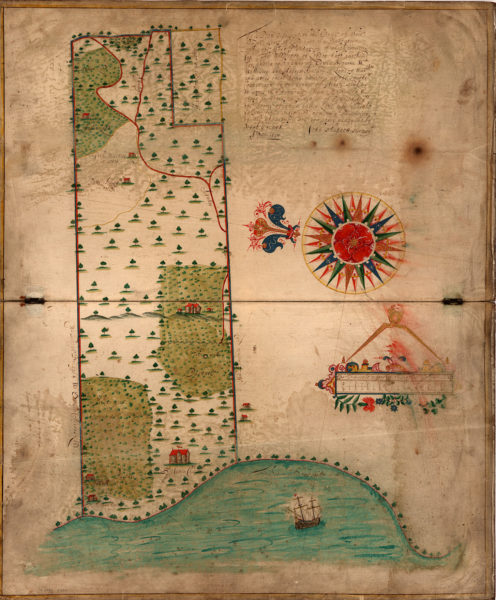
We are happy to announce the next issue of Historical Archaeology will be arriving in your mailboxes soon! Here’s a preview of some of the content from the guest editor of the thematic collection on Rethinking the Archaeology of Capitalism, Guido Pezzarossi.
What if capitalism were not an entire system of economy or a macrostructure or a mode of production but simply one form of exploitation among many? (Gibson-Graham 2006:260)
This special issue takes a different approach to the archaeology of capitalism by foregrounding the inherent role of violence, coercion and inequality in the process of accumulation. We highlight how disparities in power and the ever-present potential for violence produced and intensified inequality through a variety of exploitative, coerced unequal exchanges of time, labor, materials, goods, and space. The papers in this issue look to these diverse practices and processes that produced the effects attributed to and defining of capitalism in the present. Rather than relying on a single defining trait of capitalism, be it a mode of production, “free” markets or an ideology, Our goal is to reorient analyses of capitalism away from orthodox models and definitions, and towards the diverse “unfree” and violent processes that are generative of capitalisms.
From this theoretical framing, this special issue provides a number of case studies -from diverse times and places- that blur analytical boundaries between capitalist and precapitalist contexts. These contributions latch on to common threads that transgress these divides by identifying how unequal power (of the state, of colonists or other power-wielding private actors) were instrumental in forming unequal exchanges and exploitation that served to spur accumulation for the benefit of a few and the detriment of many. Colonial contexts loom large in this collection of papers, troubling distinctions between “primitive” and capitalist accumulation and feudal and capitalist regimes that purify overt violence from “modern” economic systems.
Articles:
Rethinking the Archaeology of Capitalism: Coercion, Violence, and the Frictions of Accumulation by Guido Pezzarossi
Capitalism and the Shift to Sugar and Slavery in Mid-Seventeenth Century Barbados by Douglas V. Armstrong
Violence and Dispossession at the intersection of Colonialism and Capitalist Accumulation by Stephen Mrozowski
Ruins, Resources, and Archaeology: Valuing People and Spaces in Baltimore by Adam Fraccia
Cacao and Violence: Consequences of Money in Colonial Guatemala by Kathryn E. Sampeck
Deeper Histories of Dispossession: The Genealogy of “Proletarian” Relations in Iceland by Eric Johnson and Douglas Bolender
Western Activism and the Veiling of Primitive Accumulation in the East African Ivory Trade by Alexandra Celia Kelly
Framings of Capitalism and the Archaeology of Sugar in the Islamic Mediterranean by Ian R. Simpson
Peanuts, Pangool, and Places: Constellations of Colonial Capitalism in Rural Senegal by François Richard
‘The Destructive Character’: The Recapitalization of a Shantytown into a Suburb (After a Brief Emancipation) by Michael P. Roller
Assemblages of Production: Capitalist Colonial Labor Regimes and Other Economic Practices in Highland Guatemala by Guido Pezzarossi and Jonathan Ryan Kennedy
How can there be no History? by Mark P. Leone, Tracy Jenkins, Stefan Woehlke, Kathryn Deeley, Brittany Hutchinson, Elizabeth Pruitt, Benjamin Skolnik
Agents of Coloniality: Capitalism, the Market, and My Crisis with Archaeology by Marguerite L. De Loney
Cover image: The 1646 John Hapcott map: “Estate Plan of 300 Acres of Land near Holetown, Barbados”
Building Arguments for Contemporary Relevance at SHA2020
This is a post submitted by Terry Klein, Executive Director of the SRI Foundation about an upcoming forum at the Society for Historical Archaeology’s annual conference in Boston, Massachusetts titled: “A Forum on Archaeological Synthesis: Building Arguments for Contemporary Relevance” sponsored by Coalition for Archaeological Synthesis
Chair: Terry Klein, Organizer: Sarah Miller
Forum Panel: Evan Larson, Cheryl La Roche, Marcy Rockman, Jillian Galle, Julian Richards, Joe Joseph, Jeffrey Altschul
Collaborative synthetic research has proven to be a powerful driver of advancement in fields from ecology to mathematics. By leveraging the large research potential accumulated over the last 50 years, largely as a result of cultural resources management (CRM), archaeology stands ready to join its sister disciplines with a new synthesis initiative – the Coalition for Archaeological Synthesis (CfAS) – dedicated to understanding long-term social processes. The SHA was one of the founding partners of CfAS.
While the public remains generally supportive of historical archaeology, that support is largely predicated on satisfying people’s curiosity about the past and on to their support for the conservation of imperiled heritage resources. It has been much harder to convince our public constituencies of the practical, contemporary relevance of our work. In this CfAS-sponsored forum we seek to explore, with the audience, how we can build more persuasive arguments for the relevance of our knowledge of the past for understanding the present and how that knowledge, through archaeological syntheses and collaboration with other disciplines, might bring unique insights that can genuinely benefit public policy. We hope that those attending this forum will share strong cases from their own experiences that can both serve as compelling examples and inform more general arguments concerning the contemporary relevance of our research.
The forum will begin with ten-minute presentations by each panelist:
- Evan Larson will discuss the CfAS-funded project: The People, Fire, and Pines in the Border Lakes Region of North America. This project weaves tree-ring records and traditional knowledge to retell a story of the relationships between people and the land that is expressed in the past fire regimes and current vegetation patterns of the modern wilderness areas of the Boundary Waters Canoe Area and Quetico Provincial Park. The conversations emerging from this synthesis project are helping to recognize the historical trauma caused by attempts to severe connections between people and the land and are advancing the process of healing through the centering power of fire as an ecological and cultural process. Larson’s presentation will highlight some of the outcomes of this work to date to help showcase how archaeological evidence, in the form of tree rings and artifacts, has provided a common language that is bringing people together to discuss stewardship of the land.
- The Underground Railroad is only one form that escape from slavery took in the United States and international destinations such as Canada and Mexico also were affected. Furthermore, escape from slavery—sometimes called marronage– was a Diasporic response that could be associated but unrecognized across a wide range of archaeological sites. Synthesizing archaeological data could contribute valuable comparable resources. Cheryl La Roche’s presentation ranges from very specific examples to broad discussion of the ways in which archaeologists can begin to think about how a clandestine activity can be made visible through archaeology.
- There are two essential connections of climate change with archaeology (and the same holds true for the broader category of cultural heritage of which archaeology is a part): archaeological sites are being and will be affected by the impacts of climate change, and both methods and findings of archaeology hold unique data and insights for climate change response. Marcy Rockman will discuss how historical archaeology covers the trends that have led to the modern phenomena of climate change, including capitalism and colonialism. As such, historical archaeology and historical archaeologists should be deeply integrated into efforts to address climate change. Rockman will present here is a brief overview of current efforts to get all of cultural heritage more fully into global climate response, and some ideas specifically about how to make historical archaeology a strong part of this. Key points will include attention to what questions historical archaeology asks and how they are answered, and framing what we know and how we know it for policy makers.
- Jillian Galle will discuss the Digital Archaeological Archive of Comparative Slavery (DAACS), which since 2004, has provided large, standardized archaeological datasets from sites of slavery excavated across North America and the Caribbean. Freely accessible to scholars and the public alike, these assemblages are giving historians, archaeologists and material culture scholars the ability to explore a range of fine-grained questions about slave societies, especially those related to the complex social and economic relationships between enslaved people, free people of color and enslavers. DAACS allows scholars to work, first hand, with material signatures left by millions of enslaved people who did not leave a written word in the archives, and to compare these “signatures” across time and space.
- Julian Richards will be talking about research using archaeological Big Data to study migration, settlement and economy in England. He will introduce how access is now being provided to similar data at an international scale through the ARIADNE research infrastructure. Although Julian’s example is drawn from the early medieval period it’s clear that similar approaches would be equally valid for the later historic period, and much of the data are already available.
- W. Joseph will discuss SHA actions that support the development of syntheses as well as the importance of synthesis in the form of historic contexts for cultural resource management consulting.
- Using the panelist’s presentations, Jeff Altschul will highlight the importance of collaborative synthetic research to archaeology. He will then use the recent European Association of Archaeologists (EAA) – Society for American Archaeology (SAA) design workshop on human migration as an example of CfAS’ approach to applying the results of archaeological synthesis to contemporary problems.
After the panel presentations, the forum will be opened up for a facilitated Q&A and dialogue among the audience and the panel on making historical archaeology relevant in the context of contemporary social issues, and the role of synthesis in addressing these issues.
Exploring the Submerged History of St. Augustine
This is a post by Allyson Ropp, Archaeologist at the St. Augustine Lighthouse and Maritime Museum
The St. Augustine Lighthouse & Maritime Museum houses an extensive maritime archaeology program, known as the Lighthouse Archaeological Maritime Program (LAMP). The program focuses on identifying and documenting the submerged maritime heritage of St. Augustine. Through site investigation, limited excavation, and conservation, the program works in conjunction with the Lighthouse to bring these discoveries to the public through a number of programs.
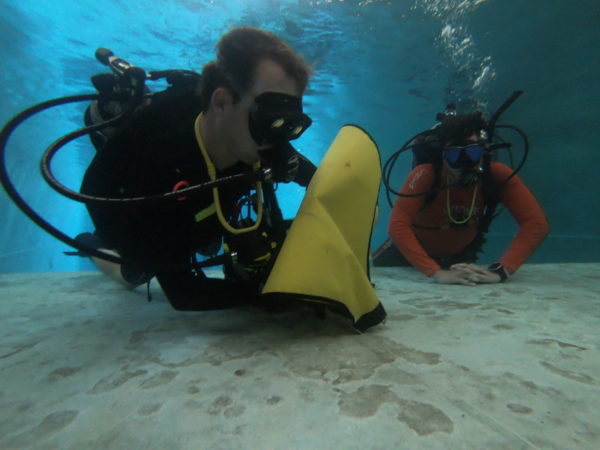
Field School student navigating through obstacle in black-out obstacle course (courtesy of LAMP 2019).
The flagship outreach program is the annual underwater archaeology field school that has occurred every summer since 2007. The field school brings in students from around the country (with the occasional international student) to learn the principles and methodologies of underwater archaeology. The students partake in a week-long scientific diver training program to get them accustomed to working in limited visibility environments, conducting scientific endeavors, and using underwater archaeology methodology. The remainder of the field school provides the students with the opportunity to put their newly acquired skills to use while working on an 18th-century shipwreck site. Not only does this program provide an opportunity for students to learn about archaeology through a classroom setting, it also offers a hands-on real-world learning environment in which they participate in on-going research. You can learn more about this underwater archaeology field school by clicking here.
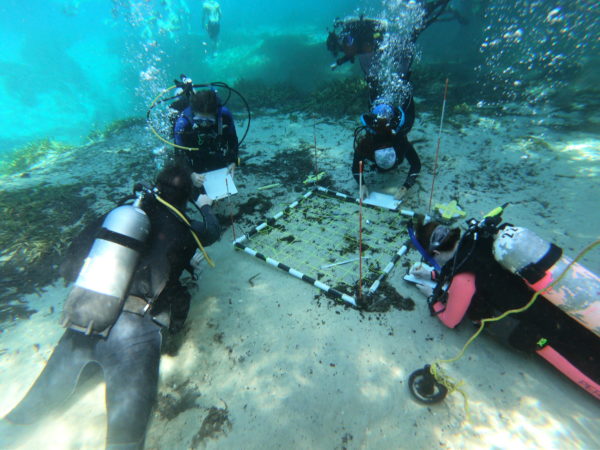
Field School students practicing mapping within a grid square (courtesy of LAMP 2019).
The program also supports additional outreach programs to support the Lighthouse itself. The Lighthouse, with support of LAMP, offers daily archaeology demonstrations that discuss the methods of underwater archaeology from remote sensing to excavation and identifying objects underwater to artifact conservation. These demos include hands-on components and visual aids that bring these different steps to life and inspire visitors, young and old alike, to use critical thinking and observation to participate in the process. Furthermore, for school groups, we offer a Shipwreck CSI program. This program offers students a chance to become maritime archaeologist through the identification of artifacts in concretions from a 1782 Loyalist vessel discovered off St. Augustine. Groups are given a concretion with corresponding x-ray to determine the contents. Once they have a guess, they match the objects inside with corresponding images of such objects to narrow a time, function, and nationality of the vessel. Using each group’s findings, the class tells the story of the shipwreck site.
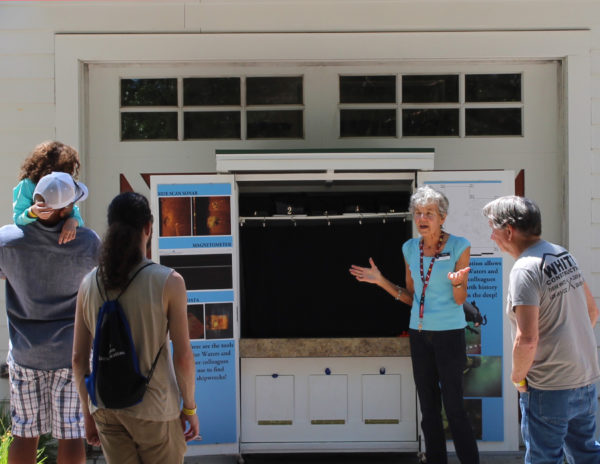
Volunteer sharing archaeology through a demo (courtesy of St. Augustine Lighthouse 2019).
The St. Augustine Lighthouse Archaeological Maritime Program and its partner the St. Augustine Lighthouse & Maritime Museum offer a multitude of ways for visitors and students to engage with maritime archaeology. To learn more about these programs and the Lighthouse itself, please visit http://www.staugustinelighthouse.org/. Applications for the upcoming underwater archaeology field school will be available in the near future.
The Importance of Childcare Support Networks for Archaeologists
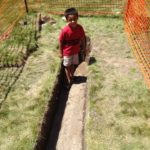
The author’s son at archaeology field project in Boise, Idaho (2015)
By William White
University of California, Berkeley
Last winter, during ski week school closure in California, several anthropology undergraduate students brought their young children with them to class. I am a professor who never minds this. I completely understand how fragile childcare arrangements can be for archaeology college students. I started my PhD when my son was two-years-old and my daughter was about six-months-old. My PhD revolved around meeting academic and parental obligations. I tried to make graduate student cocktail mixers leaving early enough to help put kids to sleep. As a grad student with children, I found that I had more in common with some of my professors who also had childcare woes than other PhD students.
Childcare is essential to being able to conduct fieldwork and research as parenting children, regardless of their age, and being out in the field does not always mix. I had my children after I had already completed my Bachelor’s and Master’s degree, so worrying about what I was going to do with my child while I took a field school wasn’t a concern. But, the presence of elementary school-aged faces in my college lecture got me thinking: What do students who are parents do when they need to go to archaeological field school? What would a single-parent professor or cultural resource management (CRM) archaeologists do when they needed to go into the field?
Attending an archaeological field school is central to becoming a professional archaeologist. Many cultural resources companies refuse to hire archaeological field technicians who have not taken a field school. Most professional archaeologists get their start as field techs. Being flexible for those early career field projects is also important for launching an archaeologist’s career in cultural resources. Having kids adds another dynamic to the decision to take a field school or the ability to be flexible in your early career.
Finding someone to take care of your kid for happy hour cocktails or a late seminar is much easier than locating someone who will watch your kid full-time while you are out of town for six weeks. Based on personal experience, I know how important both extracurricular student bonding activities and field projects are for an archaeologist’s career. I also know how I managed to meet some of those obligations without leaving my kids in a parked car at the field site (Hint: My wife watched the kids so I could do archaeological fieldwork). In fact, most of the archaeologists I know have spouses, friends, or family members who will watch their kids so they can go out into the field. I know of very few field projects where children are welcomed. Liability issues make them virtually prohibited from CRM fieldwork. In addition to figuring out how students navigate childcare and fieldwork, I also wanted to know if archaeology is conducive to parenting. Are we working in an industry that makes it easier or more difficult to be a parent?
Parenting from the Field
The expectations of a field-based career does influence an academician’s decision to become a parent. Unsurprisingly, it is women who report delaying pregnancy to pursue their career; however, having a child effects the careers of both parents in positions that require fieldwork. Lack of work-life balance is cited as a major source of stress for parents in the academy (Lynn, 2018). Academicians are frequently able to bring their children with them in the field. Fieldwork with a baby is not easy but it can be done. Collecting quality field data and taking care of a baby are not mutually exclusive (MacDonald and Sullivan 2008). Women in academia, including archaeologists, conduct substantial fieldwork while pregnant that makes significant contributions to their field (Carter 2017). As long as health risks are mitigated, pregnancy should not prevent women from conducting productive fieldwork (Sohn 2018). Accompanying parents to field projects can become an enlightening experience for children old enough to remember their experiences. While they recall being bored, tired, and hot, children of academicians recall traveling abroad on field projects with their parents had a positive impact on their lives (Barton 2014). Debates around being a mother and field researcher are an “evergreen” topic for companies, universities, students, and scholars. The particulars of being a mother and doing fieldwork are the focus of an upcoming book from Rutgers University Press titled “Mothering from the Field: The Impact of Motherhood on Site-Based Research” (Muhammad and Neully, editors; 2019).
Archaeologists are already having intense conversations about parenting and fieldwork online. On Facebook archaeology groups and CRM Archaeology Podcast Episode 158 you can find lengthy discussions about how parents handled children for fieldwork. Episode 158 unearthed deeper revelations about how having kids can affect a parent’s career. Fieldwork oftentimes delays an archaeologist’s decision to start a family. The constant childcare dance prevents some from even entering the field and drives others out of it. Parenting only gets more complicated as older children have emotional and psychological needs younger kids do not. It is important to be present for an older child’s activities and be there to help them thorough the dilemmas of being a teenager. Advice and presence becomes more important as a child gets older.
While professors and academic researchers have the freedom to bring their children to the field, this is rarely possible for CRM archaeologists or students. Liability issues on CRM projects prevent children from being present on most CRM projects. Typically, only principal investigators and company owners have told me they brought their kids to the field. Students may not even know they can ask to bring their kids with them to the field. (FYI: Do not be afraid to ask if you can bring the child with you to a field school. The worst they can say is ‘no’. Also, the response of your supervisor and co-workers will give you an excellent idea of how conducive this workplace is going to be for parenting.)
For an archaeologist, a strong network of family and friends are paramount to making fieldwork happen. Having a supportive spouse makes it easier for archaeology students to get their field training when a field school is not amenable to children. Supportive family or close friends can also fill the childcare void while also providing a nurturing environment for children while parent(s) are away. This is even more important for archaeologists who are single parents. The economics of childcare are also an ever-present consideration for any archaeologist who has to go into the field. Can you afford the kind of aftercare or preschool that will allow you to get back to town from the field? Can you compensate folks for taking care of your kid while you are in the field? Most archaeologists are not able to afford this kind of childcare, which is something companies and field school directors need to start taking into account as childcare problems undoubtedly drives away many talented archaeology parents.
What do I tell students?
Raising children is not easy. Doing archaeological fieldwork as a parent is even more difficult. But, archaeology is full of parents who have managed to get an education (including field school), forge a career, and raise their children. Without children, there would be no archaeology. However, we live in a world where archaeology is not conducive to being a parent. I feel more can be done to make it easier for students to bring their children with them to the field. I understand that not all projects will be able to accommodate children, but professors and anthropology departments can do a better job of creating local field opportunities where children can be present.
I do not believe CRM will be able to provide opportunities for archaeologists to bring their children with them to the field as it would violate too many liability clauses and occupational hygiene ordinances. The companies I’ve worked for do a pretty good job of letting management bring their kids to the office, but I think they could do more to help up-and-coming field technicians who are parents. The best thing they could do is hire some of these folks as permanent employees, which would remove some of the precarity of having to be ready to do fieldwork at the drop of the hat. This means creating opportunities for field techs to do office work (i.e. activities normally handled by archaeologists with graduate degrees). It will not create opportunities for all field technician parents but it would help many.
It may not always be possible, but a workplace’s willingness to allow children depends on the flexibility of management, especially those with children. Parents in management have the most power to make archaeological fieldwork more amenable to children. It is within the power of supervisors who are parents to make archaeology more realistic for co-workers who are parents.
Children are always welcome in my class, which means I need to keep doing what I can to create field schools where children are welcome. Safe, local, low-cost, public projects like public archaeology projects in Boise, Idaho through University of Idaho. On these public archaeology/field schools, children work alongside parents. Projects like these are too few, but I feel like there is space for there to be more of them in the future. We have a chance and an obligation to make sure parents can bring their children with them to field school.
A field archaeologist’s career success depends on the social networks. Archaeologists are not the only ones who travel for work. Archaeology families have to work together to help make fieldwork possible. The parents among us also need to remain mindful of the ways archaeology is not supporting parents and to remedy the mechanisms that keep parents out of the field. Those without children may not be aware that they are hindering an archaeology parent’s progress. It is also up to archaeology as a profession to do whatever it can to help make parenting and archaeological fieldwork possible. We can follow the lead of field scholars in academia to make it easier for parents to be with their children in the field.
References
Barton, Erin
2014 Innocents abroad: Fieldwork with family. Arizona State University (https://research.asu./stories/read/innocents-abroad-fieldwork-family) Accessed August 28, 2019.
Carter, Imogene
2017 Pregnant in the field: have trowel, will travel. The Guardian, July 1. (https://www.theguardian.com/lifeandstyle/2017/jul/01/pregnant-in-the-field-blog-photography-have-trowel-will-travel). Accessed August 28, 2019.
Lynn, Christopher D., Micaela E. Howells, and Max J. Stein
2018 Family and the field: Expectations of a field-based research career affect researcher family planning decisions. PLOS One, 13(9). (https://www.ncbi.nlm.nih.gov/pmc/articles/PMC6128561/). Accessed August 28, 2019.
MacDonald, Joan Ramage and Maura E. Sullivan
2008 Mothers in the Field. Chronicle of Higher Education, October 24. (https://www.chronicle.com/article/Mothers-in-the-Field/45801). Accessed August 28, 2019.
Muhammad, Bahiyyah M. and Melanie-Angela Nuelly, editors
2019 Mothering from the Field: The Impact of Motherhood on Site-Based Research. Rutgers University Press, New Brunswick.
Sohn, Emily
2018 A guide to juggling fieldwork and pregnancy. Nature: International Journal of Science, February 14. (https://www.nature.com/articles/d41586-018-01851-3). Accessed August 28, 2018.
Wrecks in the Sand: The Potential Relationship Between Beached Shipwrecks and Climate Change
Jennifer E. Jones, PhD
East Carolina University
The archaeological remains of ships in the beach zone are part of a complex and dynamic system, being periodically exposed and reburied, they vary between being both visible and frequently forgotten features of the physical and cultural coastal landscape. These limited and nonrenewable resources play an important informational role as tangible pieces of maritime heritage that also document dynamic coastal processes. Shipwreck remains in the beach zone are highly susceptible to instability within the landscape. This instability in turn, affects decisions regarding importance and management strategies. The challenges to certain management strategies may result in these resources being damaged, ignored or forgotten, leading to a potential loss of pertinent social, economic, and physical information. Although little can be done to prevent natural coastal processes, a better understanding of them allows for their mitigation and management. Elements of the beach environment are common to all sites, but regional and local environmental conditions dictate certain challenges to management and the stability of the beached wreck resource. Sand movement, extreme storms, shoreline change (e.g. accretion and/or erosion), and the physical effects of climate change (e.g. sea level rise) may present both challenges and advantages to protection the beached wreck resource.
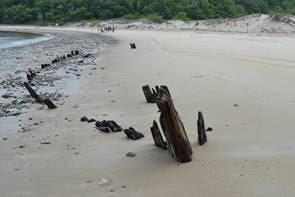
Ada K. Damon shipwreck on Crane Beach, Ipswich, MA; photo-Jones 2015
With the continued threat of sea level rise as a major component of climate change, many managing entities are focusing on sea level rise and climate change in their management plans, especially as environmental changes are already being seen in national parks and seashores. For example, climate change is considered “probably the biggest over-arching management issue that faces [Assateague National Seashore] with changing conditions” (Jones 2017). Although “steeped in politics” (Jones 2017) and varying perceptions of its occurrence, some managers see that subject of climate change as an opportunity to address the vulnerability of coastal cultural resources such as beached shipwrecks and get multi-agency support for monitoring and protection (Jones 2017). This requires a balance between the protection of the resources and their use, as well as the well-being of the public. In other words,
“…How are we going to get our visitors, our stakeholders to really appreciate and care about what’s happening on [barrier islands like] Assateague when other coastal communities…[are] going to be facing real issues with personal property and rising waters and coastal storms? Are people still going to care about these undeveloped natural areas [or cultural resources] along the coastline? I guess in the same breath, how can we make these [resources] contribute to the resiliency of those developed areas? We tend to think if we have a healthy barrier island system, we’re providing an ecosystem service or function as a protective barrier to the mainland communities. In the scenario of sea level rise and global climate change; how can we continue to increase the resiliency that we’re providing?” (Jones 2017)
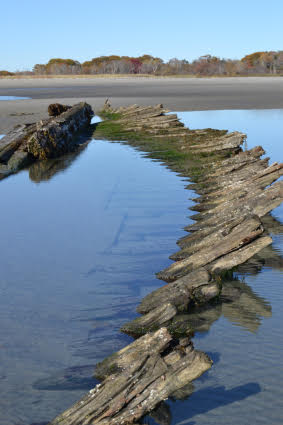
Howard W. Middleton Shipwreck on Higgins Beach, ME; photo by Jones 2015
The same can be considered of the cultural resources and its importance and maintenance in the cultural resiliency of coastal communities. If and when climate change and sea level rise continues to occur:
“…more and more we will see circumstances where we need to step in. Now what do you do? I think in most cases you have to look very carefully at what has been exposed, and what you do with it. In some cases, if it’s part of a regular program in which it’s monitored and….it has shifted a mile or half mile, then that information—tagging it, plotting it—helps better understand the site formation processes in that environment. It also gives us a sense of time if we continue to look at these, let’s say over the next 100 years, you can say this is what happened and from that draw inferences. In other places where [you] do an excavation in time…does it naturally follow, given the way we think it all works, that a 1600s wreck [for example] on the beach has gone, will be completely gone? Or would the archaeological survival, not just of the heavy stuff that sank further down, but more of the buoyant material floating somewhere in a matrix of sand and water? I think that’s the key. So consistently going out, checking, monitoring, responding to these things is important, but then making some decisions on what we’ve learned” (I-31).
“Can we learn from the beached shipwrecks as indicators of climate change? If we are finding more beached shipwrecks, is it because people are paying more attention or is it because physical processes (e.g. storm cycles, shoreline change, sea level rise) are changing (I-31)? In the end, nature is in change. Shipwreck sites are going to be exposed on beaches. They are going to break up in part. They’re going to shift around and move; that’s part of it, that’s part of the process. And if you can track it, monitor it, its’ not unlike in some ways…tagging of marine life…So to that end, I think the biggest impact then comes when people interfere with those processes” (Jones 2017).
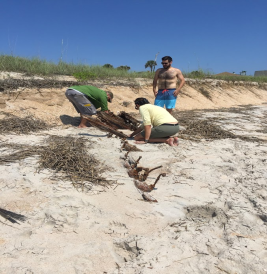
BEFORE: Ponte Vedra Shrimp boat on Ponte Vedra Beach, FL; photo by Jones July 2016
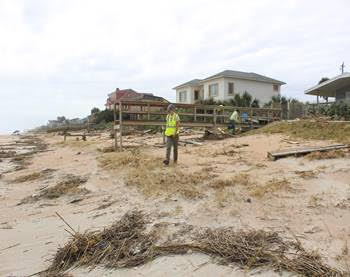
AFTER: Ponte Vedra Beach, FL; photo by Miller 2016 October 2016, post Hurricane Matthew
The resource’s link to climate change and shoreline change was also expressed by several of the managers, and the resource’s ability to provide environmental and physical information was becoming more important in data collection and management decisions. Along those lines, climate change is a growing concern for managers as well, in terms of both its effect on the resource and perceptions of its occurrence along the eastern seaboard. Although climate change denial is of regulatory concern for some managers, physical changes in shoreline and exposure of the resource are major considerations for effect on resource stability and how the resource can and will be managed as changes continue to occur. Most of the managers work on an ad hoc or case by case process, even within a larger regulatory framework. While some state and federal entities are preparing extensive plans for climate change (e.g. Maryland), most entities are still focused on a reactionary basis to issues of change and stability.
Additionally, as climate change continues to present effects along the coasts, indications of such change are essential to understanding these effects (e.g. shoreline shifts, extreme storms). As research begins to pick up speed looking at climate change and its relationship to archaeological resources, specifically terrestrial—and more recently underwater—coastal archaeological features must be added to this discussion. As embedded features within the coastal landscape, beached shipwrecks stand to contribute to the discussion on climate change. These resources, if monitored and documented over time, can expose both short- and long-term fluctuations in beach and dune systems, storm cycles, and other coastal processes. Along those lines, potential research into the effect of the beached shipwreck on the stability of the landscape is warranted. For example, a recent discovery on Reedy Island, Delaware shows probable use of a beached wreck as a breakwater on the island (Mastone 2017, pers. Comm). Along with the considered use of beached wrecks in the dunes during the WPA/CCC era in North Carolina, these we as well as other examples show the potential for examining the effects of the resource on providing stability to the beach and dune systems.
Jones, J.E.
2017 On a sea of sand : a comparative analysis of the challenges to beached wreck site stability and management. Doctoral dissertation, Coastal Resources Management, East Carolina University, Greenville, NC.
New Thematic Collection – Excavating ‘The Garden of the North’: Five Centuries of Material and Social Change in Western Massachusetts
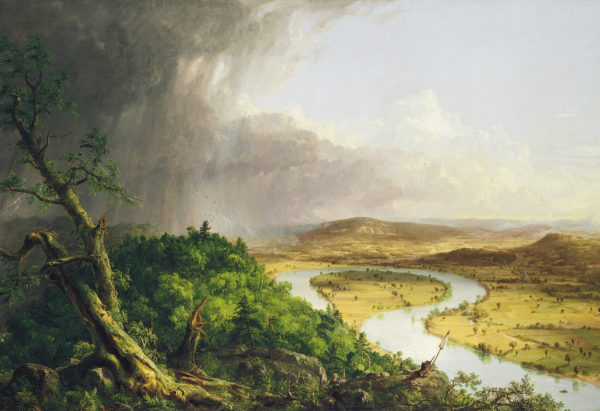
Image: The Oxbow, View from Mount Holyoke, Northampton, Massachusetts, after a Thunderstorm The Oxbow by Thomas Cole
Archaeologists Working with High School Students
By Patricia Samford, Maryland Archaeological Conservation Laboratory, Jefferson Patterson Park and Museum
Several years ago, I told a colleague that I was working with a group of high school students, cataloging and writing up a mid-19th century privy assemblage, excavated forty years ago in Baltimore. She was aghast, insisting that the students would surely screw something up and asking why I would even consider working with students that young. I politely reminded her that the freshmen enrolled in her field school were only a year or two older than my students – so I didn’t really see any great difference in what we were doing. In fact, when students are interested and engaged, working closely with professional archaeologists, there is no more reason to worry about the accuracy of their work than there is with college students. High school teachers are often looking for these types of hands-on, real world learning activities for their students. Finding a willing and flexible school educator and committing the time to work with students can yield great results for everyone.
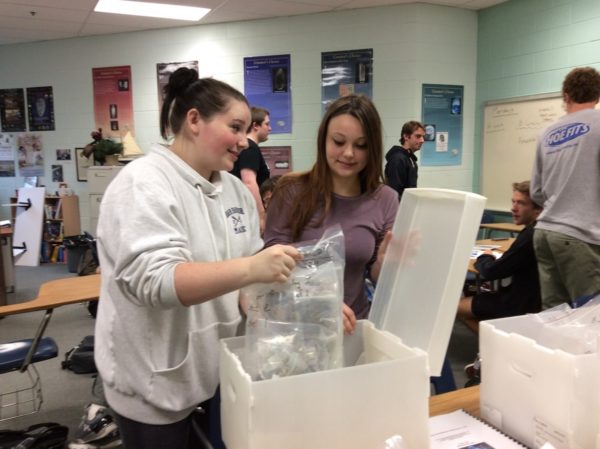
Figure 1. Huntingtown High School students getting a first look at the artifacts they will be studying during the school year.
For the last seven years, archaeologists and educators at Jefferson Patterson Park and Museum, Maryland’s State Museum of Archaeology, have been working with the Calvert County Public School system to provide archaeological opportunities for students at one of the county’s high schools. The park is home to Maryland’s archaeological curation facility—the Maryland Archaeological Conservation Laboratory—and, as such, is easily able to offer students the opportunity to work with an artifact collection each year. The site we have been focusing on – the Federal Reserve Site (18BC27)—encompassed a full city block in Baltimore and the 1980 excavation uncovered the subsurface remains of approximately fifty privies and row house cellars. Each year, the lab’s archaeologists choose a discrete assemblage—usually a privy with two or three boxes of artifacts—for the students to work with.
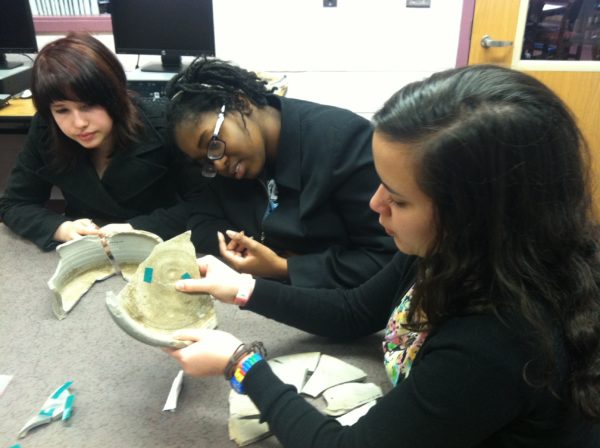
Figure 2. A collaborative mending project on a mid-19th century North American stoneware spittoon.
Throughout the course of the year, students work weekly with museum staff to catalog, mend and research the assemblage’s artifacts. As the capstones to their project, the students give a public presentation on their work, as well as plan and create a small exhibit for the public library and their school. During the process of analyzing an artifact assemblage from start to finish, the students gain valuable skills in writing, research, teamwork and public speaking. The Maryland Archaeological Laboratory benefits from having an understudied archaeological assemblage cataloged and analyzed.
Of course, conducting a program of this type is not without its challenges and park staff have learned over the course of the last seven years how to create an environment that facilitates learning and success. The lessons below relate generally to collections-based projects like those we have been conducting with the students at Huntingtown High School, but could be applied to fieldwork-based projects as well. Some of the lessons we have learned include:
- Don’t assume the students will have any background knowledge at all about archaeology, site formation processes or how to interpret artifact data. Be prepared to have the “no, archaeology is not about dinosaurs” talk and use lots of visuals to help students understand how archaeologists work.
- If possible, take a visit to an active archaeological site or an archaeological laboratory to see work in process. Visits like this will help students understand better the processes involved with archaeology.
- Limit the size of the student group based on the number of staff you have working with the students. A ratio of one staff to three or four students worked well for us.
- We learned to pare back on our original overall project goals – for example, it was very quickly became apparent that the time constraints posed by the school year and MAC Lab staff availability made it unrealistic to expect the students to write a technical report on their feature.
- Activities that involve working with the actual objects are going to be more popular and engaging than tasks that involve writing or researching. Find ways to make these less hands-on tasks more enticing by relating them to people from the past. Our students were particularly interested in doing research with online census data and with newspapers.
- Closely monitor research activities – kids will want to do all research on their phones and often choose sources that are unreliable.
- Build in more time than you think you need for tasks—at least twice as much as you would for a beginning professional. Things like standardized testing and the lack of focus during the pre-holiday periods mean that productivity declines (for everyone!).
- An important component of our project was incorporating ways to improve writing and public presentation skills. Be ready to offer constructive criticism in a supportive environment.
- Realize that you are not going to get as much focus the last month of school as you have the remainder of the year and plan accordingly.
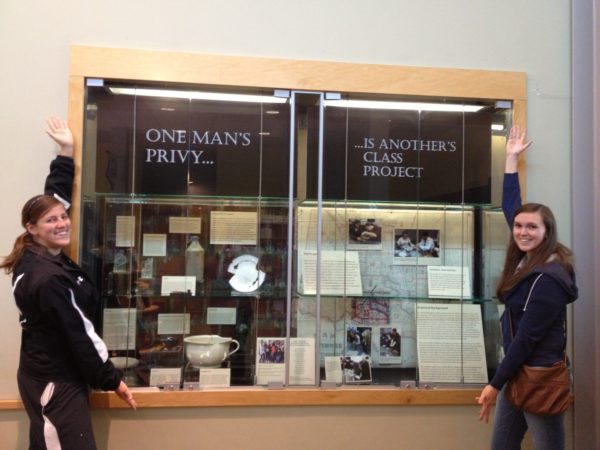
Figure 3. Students proudly showing off their capstone project: an exhibit in the local public library, appropriately named “One Man’s Privy…Is Another’s Class Project”.
Sometimes, as I leave a stack of work towering on my desk as I depart for the journey to the school, I wonder why the lab got involved in a project that demands so much of our time and energy. But, when I reach the school, and see the enthusiasm with which the students approach this project, I know that we have made the right decision. And, the students’ enthusiasm always reminds me why I got into archaeology in the first place—that excitement that we feel when we engage with the past. Two years ago, the students got so interested in the family whose trash we were studying that they used Ancestry.com to track down and contact living descendants to tell them about their project. And what makes the past come alive more than that?
Branding, Buy-in, and Archaeology Partnerships
By John P. McCarthy, RPA
Delaware State Parks
In 2014 as a new employee of Delaware State Parks, I was charged with reactivating the Time Traveler volunteer archaeology program (https://destateparks.com/Programs/TimeTravelers). I knew from the outset that rebooting a program that had been idle for at least a decade was not something I could do by myself. I needed to develop a brand for the program, get buy-in within my agency, and find partners with whom I could develop relationships that would leverage the meager resources available to me. I offer my experiences as a case study in building public archaeology partnerships.
Branding and Mission
One initial thought I had was that Time Travelers should not simply be about archaeology, but should address cultural heritage writ large. What I came up with was a two-pronged approach. While Time Travelers would be reestablished as a volunteer program for hands-on archaeology and other cultural heritage-related activities, it would also be a branding effort for cultural heritage-themed programs and events in the parks. This would give cultural heritage programs a unified identity and connect those programs to hands-on, participatory opportunities.
Part of the branding effort was development of a visual identity for the program. I worked with our Creative Services group in developing a new Time Travelers logo that reinforced the connection to State Parks that had been missing in the logo created in the mid 1990s.
Internal Buy-In
Delaware State Parks is a 67-year old organization managing over 20 parks, preserves, and natural areas totaling about 400,000 acres. Like most organizations, there are many fiefdoms, and turf is carefully guarded, sometimes extremely carefully guarded. Accordingly, I recognized that internal partnerships were going to be very important, and my boss and I met with the Chief of Interpretation and with Chief of Volunteer and Community Involvement as soon as I had some notion of what I wanted to do with the Time Traveler program.
In these meetings, my boss stressed that revival of the Time Traveler program was a priority that upper management had endorsed when filling my position. To the interpretive program I pitched the idea of Time Travelers as a branding for public outreach/education events and activities in State Parks with a cultural heritage focus. With the hope that such activities and events would serve as a recruitment gateway for potential volunteers, I committed to doing public talks and other programs on a regular basis. While there is a Chief of Interpretation in State Parks’ central office, interpretive programming in the parks is initiated and scheduled by Interpretive Managers and staff in each park. I was invited to introduce myself and pitch the Time Traveler concept at quarterly meetings of the interpretive staff, and I found enthusiastic supporters in several parks with whom I developed presentations for the general public and summer day-camps. Positive responses from the public to the programs developed with those initial contacts has led to interest from other park units and the development of additional programs. I’ve also reached out to local historical societies and metal-detector clubs and have presented programs to their members, gaining a few new potential volunteers each time I speak.
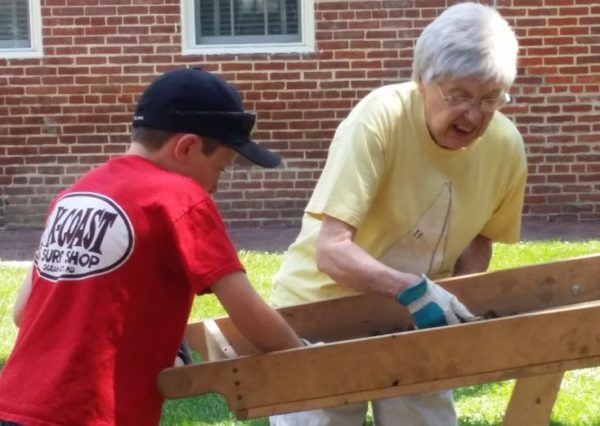
Multiple generations of Time Travelers (courtesy McCarthy 2019)
Our chief of volunteer programs immediately embraced the concept and paid for the printing of 2,500 logo stickers and 100 embroidered patches out of his budget. He recently paid for a second order of sticker and patches. He also worked with me to develop a position description for archaeology volunteers and an online application form, integrated with the systems he had previously developed.
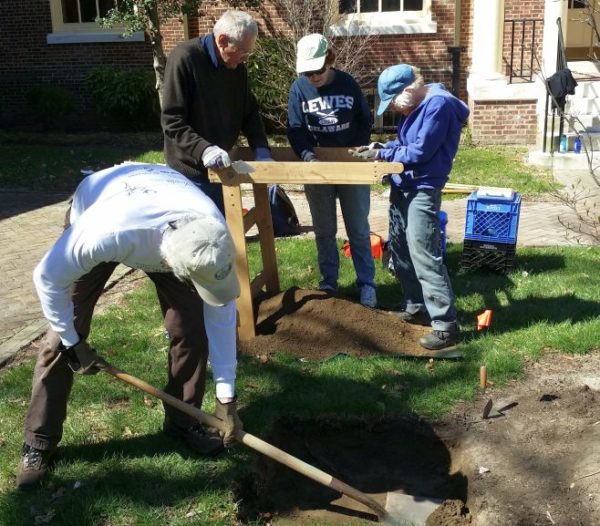
Time Travelers working at the Bell House (courtesy McCarthy 2019)
Outside Partnerships
Looking outside the agency, I first reached-out to the Archaeological Society of Delaware (ASD) who had been running a successful excavation at a 17th-century historical site near Rehoboth Beach for several years. In exchange for access to their emailing list of over 100 members, I sold my soul and became the new treasurer of the ASD, a position that I suspect I may end up holding for life. In our first Time Traveler field projects veteran ASD members made up most of the teams, but not exclusively so, and the experienced hands were paired with those having little to no experience. I continue to have a close relationship with the ASD, and the ASD has helped staff and fund a number of events and activities.
Delaware has two state-recognized Native American groups: the Nanticoke Indian Association and Lenape Indian Tribe of Delaware. There are no federally-recognized tribes resident in the state. I reached out to both tribes initially via email, and when that was not successful with the Nanticoke, via telephone. While I was easily able to make contact with the leadership of the Lenape and meet with them, attempts to contact the leadership of the Nanticoke have proven more difficult and will apparently require face-to-face introduction by someone known to and trusted by the Tribe. This has yet to happen, but I think I have found someone willing and able to make that introduction.
My initial goal in contacting the tribes was to explore their attitudes toward archaeology and interest in potential research projects. The Lenape’s Chief Dennis Coker was cautious positive in his reaction, having had in the past both positive and negative experiences with professional archaeologists, but our conversations were positive overall and lead to a partnership among ASD, the tribe, and State Parks to put on a festival event called Native Ways. I began to meet regularly with the Lenape Tribe’s Outreach Committee, a group run by respected female members of the Tribe, and they are now enthusiastic in their support for archaeology.
The Native Ways event was held in the Fall of 2016 and 2017, presenting native spirituality, foodways, and technologies presenters at stations where the public could interact with the presenter and try their hand at many skills, including cordage making and atlatl-assisted spear throwing. The 2017 event grew to two days with good public attendance. Changes in staffing at the park where the event was held, however, resulted in the event not being able to be held since, but we are planning shorter programs focused on particular craft activities, such as pottery-making, and I have presented a talk on regional prehistory as part of each year’s Lenape Heritage Month (September) for the last four years.
Summary
In reviving the Time Traveler volunteer program, I found it useful to redefine its mission and the brand of the program. It was also vital to get internal buy-in for my program objectives and develop external partnerships with groups with whom my program shares a similar mission and goals. The success of such relationships is in addressing some need of all those involved, but can draw on the resources of each to build capacity and achieve outcomes that would be otherwise impossible.




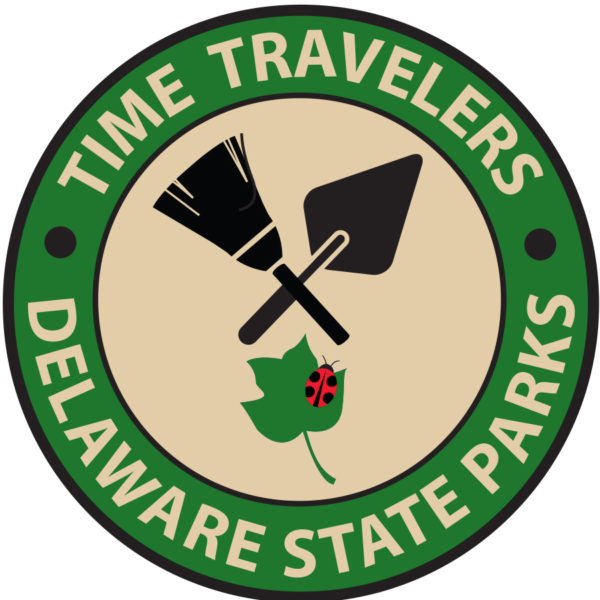
Pingback: WAC May 2012 eNewsletter – Volume 40 – World Archaeology Congress